Pewag makes many chains, primarily for commercial and industrial applications, such as lifting heavy equipment, tire traction control, and tire protection. They initially designed their famous 12mm 3012 chains for traction purposes, but their strength and impressive qualities made it a highly functional security chain. Pewag created an original security chain utilizing the same basic design as the 3012. Still, for longevity, they added an anti-corrosion electro-galvanized finish and now offer it in three practical sizes, 7mm, 10mm, 12mm (9/32″, 3/8″, and 1/2″).
For further information, refer to pewagchain.com.
Each of the chains has a Surface Hardness of 62 HRC, which makes it challenging to cut, and the square shape of the link prevents bolt cutters from getting a proper bite. These qualities make them ideal for locking up your bicycles, motorcycles, and other valuable equipment.
Highlights
- Square, case-hardened links
- Electro-galvanized finish for corrosion protection
- Surface Hardness: 7 and 10mm 62Rc 10% deep/49Rc core min, 12mm 62Rc 6% deep/43Rc core min
12mm Chain
During this review, I tested all three chain sizes but found the 12mm or 1/2″ version with a Viro shrouded lock the most ideal and theft-resistant setup for protecting bikes. You can purchase any chains by foot or as a kit with a lock (2-20 foot lengths) from various rigging supply companies on the internet. Though they aren’t cheap, especially the 12mm model, they are worth the investment to protect your precious, pricey bikes against theft opportunists. You can also get a nylon chafe sleeve to protect things from the chain, though I cut an old innertube to keep my bike and rack from getting banged up.
Be forewarned, the 12mm is a massive brute, and a 6-foot chain weighs around 20 pounds, and it’s not something you’d want to throw around your waist. On the other hand, toughness, heft, and difficulty to cut make it ideal as a high-security chain to lock your bike at home, in the garage, and on your vehicle’s bike rack.
Viro Locks
A comparable lock is required to match the impressive high-security Pewag chains, and the Italian Viro company makes some of the best in the business. The solid Viro EuroMonolith is a high-security padlock, which is designed to work with a 7/16″ (12 mm) square security chain. The body is constructed from a one-piece, special case-hardened and tempered steel, and the finish is achieved via an exclusive “NIPLOY PROCESS,” which results in a corrosion-proof nickel plating.
For further information, refer to www.viro.it.
The deadbolt is made from case-hardened, tempered steel. The security cylinder has six pins and is protected by a rotating anti-drill plate made of special 4.4-mm-thick, case-hardened, tempered steel. It also uses pick-resistant dimple nickel-plated brass keys.
The EuroMonolit’s design completely shrouds the deadbolt, and when protected by the 12mm square security chain, thieves won’t have access to bolt cutters or a grinder. An expert lock picker can get through most locks, but it’s much easier and quicker to just cut the chain.
Cut Testing
I cut all the various-sized chains with a powered angle grinder with an aluminum oxide wheel, with the chain locked down tightly in a vise. I also tested cutting the chain with it hanging loosely, which is how it would be in a typical situation when your bike was locked down. It took around 15-20% longer when it wasn’t secured in a vise since the chain moved around somewhat and caused the wheel to bind occasionally during cutting. During my testing, I pushed as hard as possible with my angle grinder to cut through the 12mm chain, not caring about the grinder wheel, things binding up, and my safety. After experimenting and running multiple tests, I’d think it would take under 1 minute to cut the 12mm chain in a real-life situation. I tried to replicate how a thief would hurriedly cut the chain but could not do it correctly. The standard method is to be careful, cut slowly, not allow the wheel to bind, and move back and forth during the cut.
Bottom Line
Nothing is theft-proof, but the excellent pewag 12mm security chain with the Viro EuroMonolith pick-resistant shrouded padlock requires an angle grinder to cut. Using a powered tool to cut the chain, a noisy and challenging operation, slows down the process and makes your precious item a less likely target. I’ll continue to use the 12mm chain and the shrouded lock to secure my bike on my truck’s bike rack, in the bed of the topper, and even on various racks around town.
Any pewag security chain with a shrouded lock is an ideal candidate as a theft deterrent to protect your bike, with highlights to their 10mm and 12mm sizes.
About pewag
The Austrian based pewag industrial conglomerate is one of the oldest chain manufacturers in the world and traces its lineage back to a forging plant in 1479. Their well-engineered state-of-the-art quality products mainly focus on snow chains, forestry chains, hoist and conveyor chains, do-it-yourself products, engineering, lifting and lashing chains and accessories and tire protection chains. The international company has locations throughout Europe, and several locations in the US, including our local favorite in Pueblo Colorado (they produce traction chains).
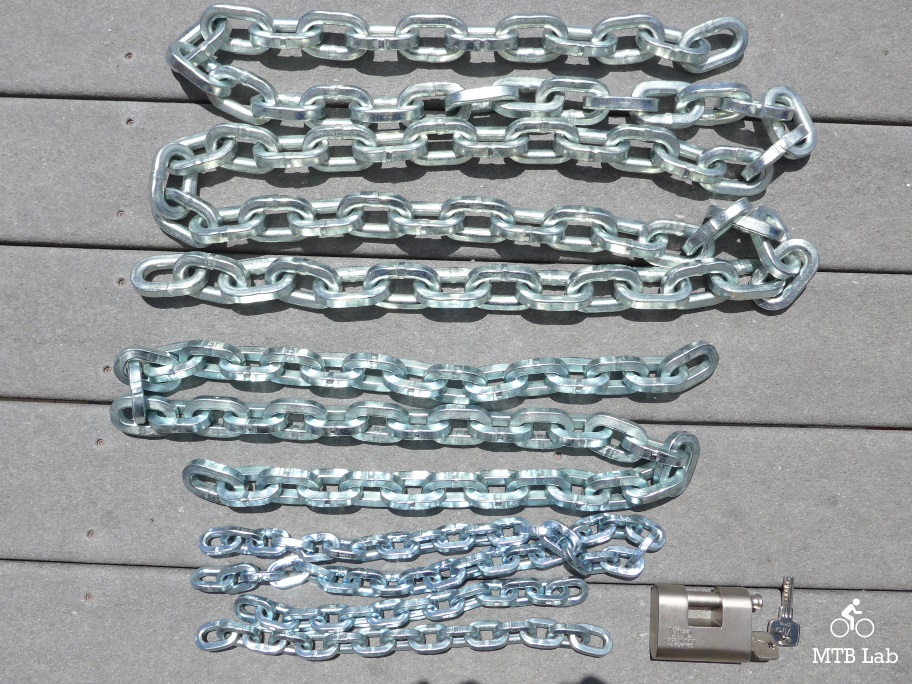
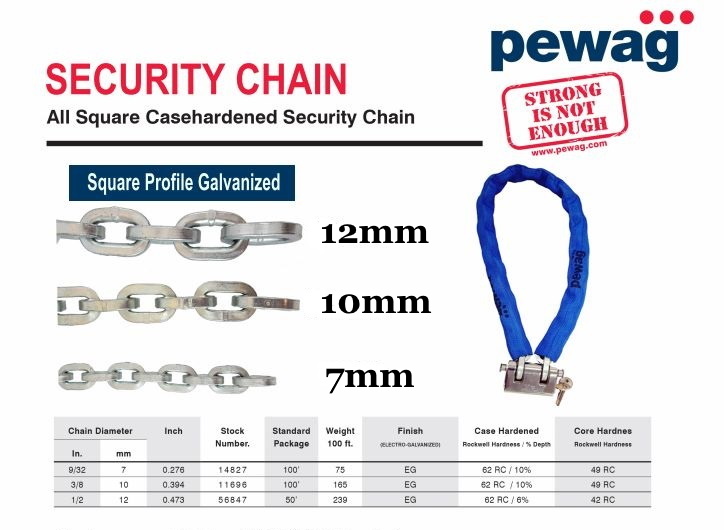
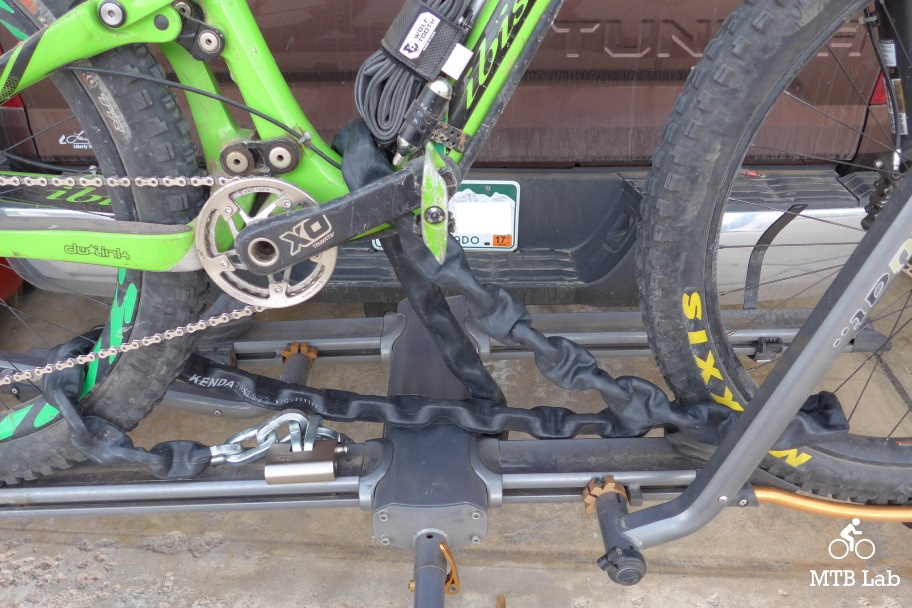

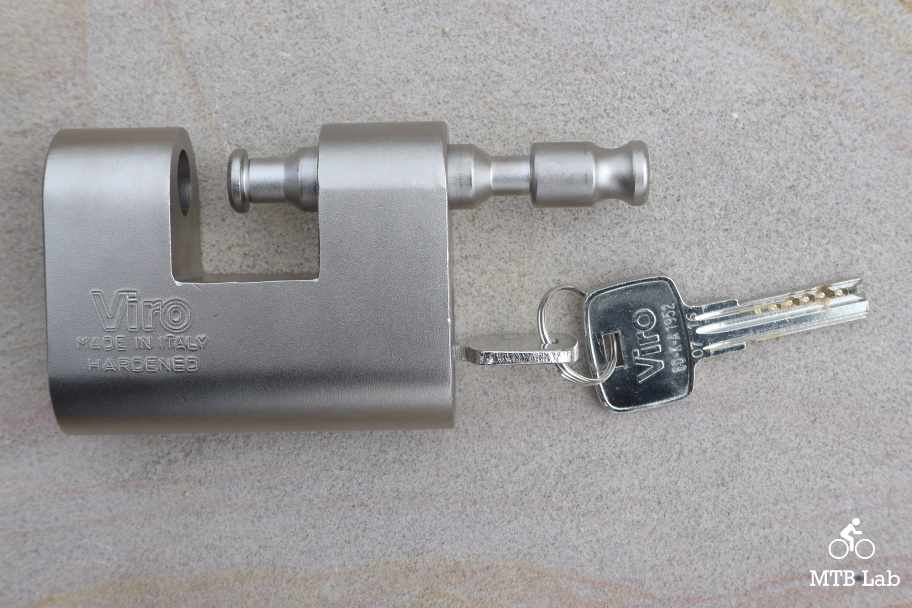
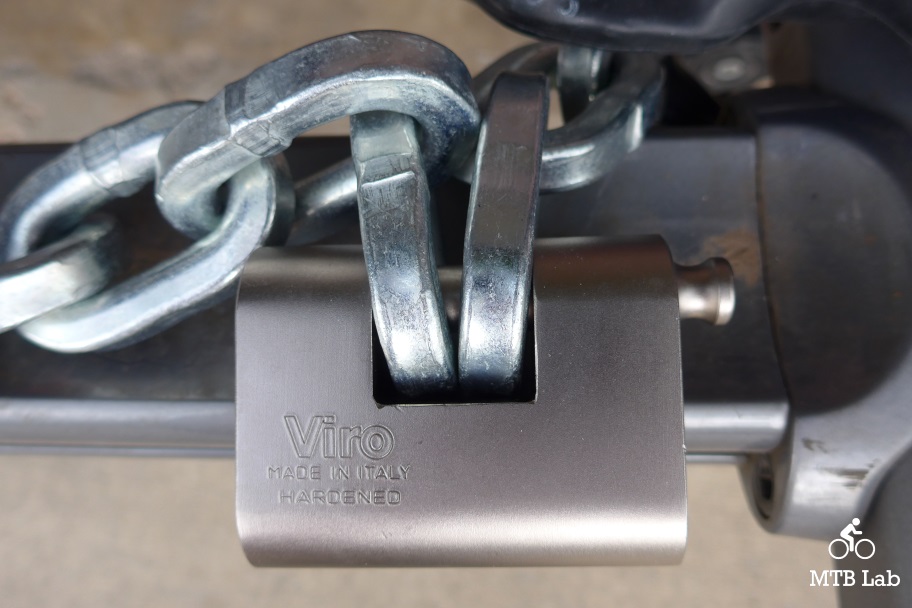
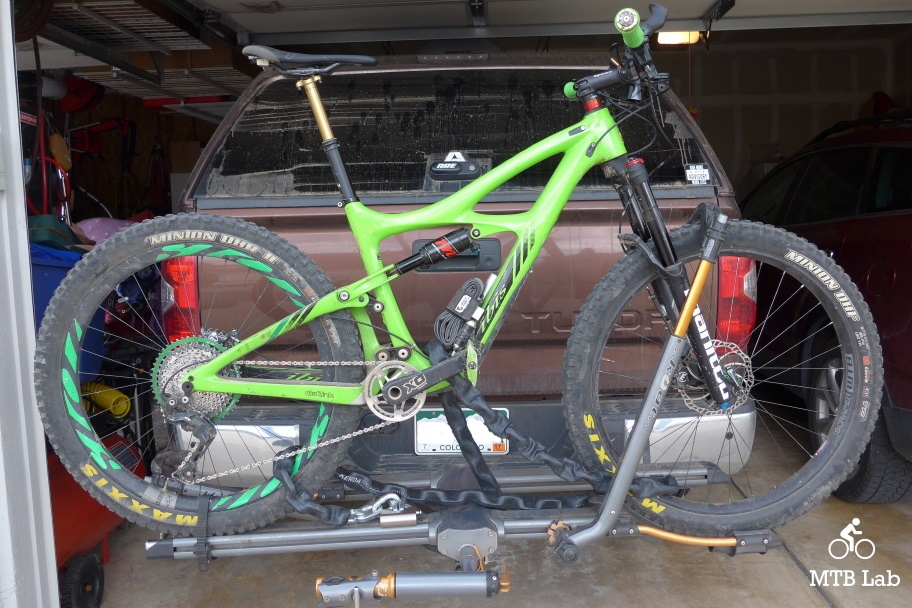






{ 13 comments… read them below or add one }
Thanks for taking the time and nice demo-write up.
Next to Almax (UK manufactured, unavailable in the US, that make chain links up to 25mm in diameter for motorbikes in mind….check out their videos demonstrating the use of “bolt croppers” against their products and their competition for entertainment/awe and the video on Viro manufacturing/assembly) Pewag and Pragmasis (in that order) are likely next in the hierarchy (IMO). All three Pewag size security chain links are (supposedly) resistant to hand held bolt cutters (hardened steel more than 42″ Irwin).
When our spendy mtbs are mounted on our sprinter based RV-1UpUSA rack for away from home sojourns, there are two 13mm Pragmasis chains through the main triangles of each-bike rack and locked together with a single Squire stronghold padlock AND an Abus 3/8″ chain with Abus lock…but we’re in the process of buying a 10mm Pewag (w/ Viro or Mul-t-lock) to replace the Abus (clearly are more vulnerable to “cropping” than the above 3) to travel through the Pragmasis links, both wheels, rear triangle and hitch-bike rack.
To top it off we bought one of the vibration-movement activated audio alarms w/ remote ($15) to place in one of the saddle bags for when we are camping or away from the RV at a restaurant, the hitch has two locking hitch pins (one tougher to access @ the front of the hitch) and a lock over the 1UpUSA over the tool access opening.
Reason for advancing our ‘optical agenda’ from Abus to Pewag was about a month ago on the way home from a mtb’g trip Hagerman-Leadville we were parked at the Frisco Whole Foods at noon and two grunge clad characters (sans visible tools or pack & clearly not mtbrs) were eye-balling our mtbs on the back of the RV and made a rapid retreat once they saw us.
(We’re committed to spending at least 10% of the replacement costs of our bikes and like the adage of runnin’ from bears, gotta make it appear to would be thieves (WBT) that there are far easier targets than this one).
Dave,
Good idea on adding a motion detection alarm. I had never heard of the Almax stuff, but it certainly looks beefy. Having the additional girth will make it even more difficult and timely to try and cut a chain. I’d love to test out the Almax 25mm chain (or any of their stuff), but its too bad they’re UK based, though they state they’ll ship overseas. Just for grins, I’ll ping them if they have any interest.
Thanks,
Brian
Brian,
Decided on purchasing a 3/8″ diameter link chain from Laclede with a Rockwell hardness rating of 62-65 w/ Cisa shrouded shackle padlock & some highly visible Pewag chafe…the Pewag name is better known by the “higher-end” bike stealing community (pun intended) and may be an additional deterrent.
Two years ago, Laclede changed their method of hardening of their security chain (supposedly, more full thickness and to my limited knowledge is the highest in the industry) and is manufactured outside of St. Louis and thus, is a bit less expensive. (Perhaps they might send you some links to test?).
On the audio end of things, “Nulock” and other blue tooth linked audio locks show some promise as ancillary devices.
Dave
Wow that was terrible, way to fast to cut, on this video they’re showing this as a full minute to cut:
https://www.youtube.com/watch?list=PLSUdZIRSJDBTh-nCL4p4m1_QwCXnVm2Lf&v=9V_Pmapz7Ds&feature=emb_logo
like wtf man?
I am replicating how a thief would work, being careful and safe is not how they proceed. Fast is the only goal that is used.
What length of chain did you use in order to lock the bike to the rack?
Andrew,
It’s a six-foot chain.
The MTB Lab
And then they just unscrew the rack lol.
When I actually use the rack I run a second chain that goes to the frame of the truck.
The MTB Lab
Yes, you used a corded angle grinder, a thieve has one on batteries, unless he takes a diesel generator with him, mm, then it takes way longer and is even more dangerous because of less power, you use a thinner blade, wich can come flying of.. Good chain if you ask me!
Exactly. I didn’t see a need to go purchase a battery powered angle grinder to complete the full test. The chain is pretty stout is an excellent deterrent.
The MTB Lab
Hey man, this is awesome to see. I need a lock for our 4-bike Yakima Hold-up and Lolo rack too. Something for when we are gone for a short while and camping. I’m thinking I need about 12ft to get through all of the bikes. The 1/2in looks sweet but I’m wondering if I could get by with just the 3/8ths. I’m wondering if there is a big difference between the two.
Also, is there any concern of the heavier 1/2in chain damaging your carbon frame when its stationary and locked?
Always better to go with the 1/2-inch chain. It’s more of a deterrent to cut, making it the best choice in their lineup. You’ll want to get a nylon chafe sleeve (tubular webbing) or use an old bike inner tube to protect your frame.
The MTB Lab